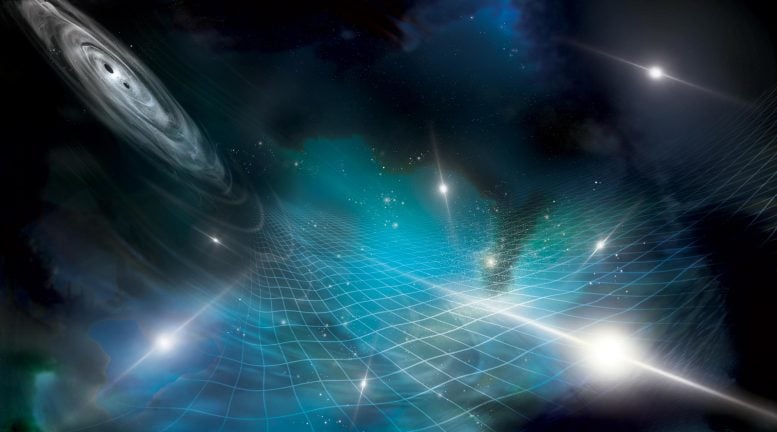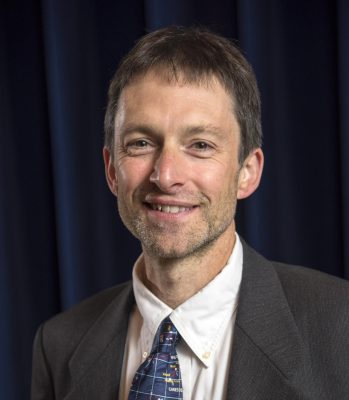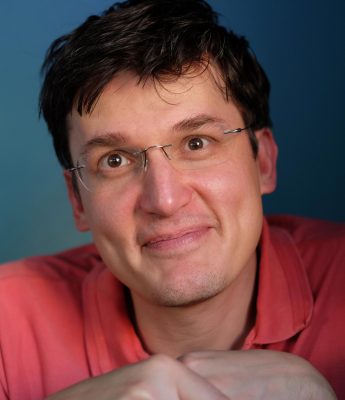Artist’s concept of a collection of pulsars that detect gravitational waves from pairs of orbiting supermassive black holes. Credit: Aurore Simonnet for the NANOGrav Collaboration
Scientists have reported the first evidence that our Earth and the universe around us are awash in a background of spacetime undulations called gravitational waves. The waves oscillate very slowly over years and even decades and are thought to originate primarily from pairs of supermassive black holes leisurely spiraling together before they merge.
A 15-year Pursuit
This groundbreaking discovery, detailed in a series of papers in The Astrophysical Journal Letters, is the result of 15 years of meticulous observations by the North American Nanohertz Observatory for Gravitational Waves (NANOGrav). As a National Science Foundation-funded (NSF) Physics Frontier Center, NANOGrav comprises over 190 scientists from the United States and Canada. They employed radio telescopes at the Arecibo Observatory in Puerto Rico, the Green Bank Telescope in West Virginia, and the Very Large Array in New Mexico to monitor 68 dead stars, called pulsars, in the sky. The pulsars acted like a network of buoys bobbing on a slow-rolling sea of gravitational waves.
Building Confidence in the Findings
“The effect of the gravitational waves on the pulsars is extremely weak and hard to detect, but we built confidence in the findings over time as we collected more data,” says Katerina Chatziioannou, a NANOGrav team member and an assistant professor of physics at Caltech. “In the future, we will continue to make more observations and will compare our results with those from international partners, which will allow us to learn more from the data.”
Katerina Chatziioannou. Credit: Caltech
Unraveling Black Holes
“We have a new way of probing what happens as monstrous black holes at the cores of galaxies begin a slow but inexorable death spiral,” says Joseph Lazio, a NANOGrav team member, a principal scientist at the Jet Propulsion Laboratory (JPL), and a visiting associate in astronomy at Caltech, which manages JPL for NASA. “We think that this process is standard for many galaxies, and we’ve seen many examples at various steps, but we’re finally starting to glimpse one of the key final steps.”
Joseph Lazio. Credit: Caltech
Gravitational Waves — An Einsteinian Concept
Albert Einstein first proposed the concept of gravitational waves in 1916. However, it was not until approximately a century later that they were directly detected by the NSF–funded LIGO (Laser Interferometer Gravitational-Wave Observatory). They detected waves from a pair of distant colliding black holes.
Unlike LIGO, which detects gravitational waves with much higher frequency, NANOGrav, as the name implies, focuses on lower-frequency gravitational waves in the nanohertz range, i.e., one cycle every few years.
Higher-frequency gravitational waves come from smaller pairs of black holes zipping around each other rapidly in the final seconds before they collide, while the lower-frequency waves are thought to be generated by huge black holes at the hearts of galaxies, up to billions of times the mass of our sun, that lumber around each other slowly and have millions of years to go before they merge.
The Collective Hum of Merging Black Holes
In the new studies, NANOGrav is thought to have picked up a collective hum of gravitational waves from many pairs of merging supermassive black holes throughout the universe. “People compare this signal to more of a background murmur as opposed to the shouts that LIGO picks up,” explains Chatziioannou, who is also a member of the LIGO team and a William H. Hurt Scholar.
Patrick Meyers. Credit: Caltech
“It’s as if you are at a cocktail party and you can’t pick out any one individual voice. We just hear the background noise,” says Patrick Meyers, a NANOGrav team member and postdoctoral scholar research associate at Caltech who helped lead statistical tests of the results.
Understanding the Cosmic Hum
NANOGrav’s network of pulsars is also known as a pulsar-timing array. The pulsars, which formed from the explosions of massive stars, send out beacons of light that rapidly spin around at very precise intervals. “These are like lighthouse beacons that sweep by at a regular rate. You can predict the timing to a level of tens of nanoseconds. They have the same level of precision of atomic clocks in some cases,” says Meyers.
When gravitational waves travel across the cosmos, they stretch and squeeze the fabric of spacetime very slightly. This stretching and squeezing can cause the distance between Earth and a given pulsar to minutely change, which results in delays or advances to the timing of the pulsars’ flashes of light. To search for the background hum of gravitational waves, the science team developed software programs to compare the timing of pairs of pulsars in their network. Gravitational waves will shift this timing to different degrees depending on how close the pulsars are on the sky, a pattern first theoretically calculated by Ron Hellings and George Downs at JPL in the early 1980s.
Michele Vallisneri. Credit: Caltech
“Imagine lots of ripples on an ocean from pairs of supermassive black holes scattered throughout,” says Lazio. “Now, we’re sitting here on Earth, which acts like a buoy along with the pulsars, and we try to measure how the ripples are changing and causing the other buoys to move toward and away from us.”
“To tease out the gravitational-wave background, we had to nail down a multitude of confusing effects, such as the motion of the pulsars, the perturbations due to the free electrons in our galaxy, the instabilities of the reference clocks at the radio observatories, and even the precise location of the center of the solar system, which we determined with help from NASA’s Juno and Cassini missions,” says Michele Vallisneri, a NANOgrav team member, a senior research scientist at JPL, and a visiting associate in theoretical astrophysics at Caltech.
Further Explorations and Conclusions
Future NANOGrav results will include Canada’s CHIME telescope, which joined the project in 2019. Caltech’s Deep Synoptic Array-2000, or DSA-2000, an array of 2,000 radio antennas planned to be built in the Nevada desert and begin operations in 2027, will also join the search.
The scientists hope to answer mysteries about the nature of merging supermassive black holes, such as how common they are, what brings them together, and what other factors contribute to their coalescence.
“People have tried to find merging supermassive black holes with telescopes for years,” says Chatziioannou. “They are getting closer and finding more candidates, but because the black holes are so close together, they are hard to distinguish. Having gravitational waves as a new tool will help better understand these enigmatic beasts.”
“This was such a beautiful, unlikely experiment: assembling a galactic-size gravitational-wave detector animated by the pulse of dead stars across our galaxy and bringing together a multidisciplinary team of radio astronomers, neutron-star and black-hole experts, and gravitational-wave scientists,” says Vallisneri.
For more on this research:
Gravitational Waves From Merging Supermassive Black Holes “Heard” for First TimeGravitational Waves Detected Using “Cosmic Clocks” and Spatial Distortions
Reference: “The NANOGrav 15 yr Data Set: Evidence for a Gravitational-wave Background” by Gabriella Agazie, Akash Anumarlapudi, Anne M. Archibald, Zaven Arzoumanian, Paul T. Baker, Bence Bécsy, Laura Blecha, Adam Brazier, Paul R. Brook, Sarah Burke-Spolaor, Rand Burnette, Robin Case, Maria Charisi, Shami Chatterjee, Katerina Chatziioannou, Belinda D. Cheeseboro, Siyuan Chen, Tyler Cohen, James M. Cordes, Neil J. Cornish, Fronefield Crawford, H. Thankful Cromartie, Kathryn Crowter, Curt J. Cutler, Megan E. DeCesar, Dallas DeGan, Paul B. Demorest, Heling Deng, Timothy Dolch, Brendan Drachler, Justin A. Ellis, Elizabeth C. Ferrara, William Fiore, Emmanuel Fonseca, Gabriel E. Freedman, Nate Garver-Daniels, Peter A. Gentile, Kyle A. Gersbach, Joseph Glaser, Deborah C. Good, Kayhan Gültekin, Jeffrey S. Hazboun, Sophie Hourihane, Kristina Islo, Ross J. Jennings, Aaron D. Johnson, Megan L. Jones, Andrew R. Kaiser, David L. Kaplan, Luke Zoltan Kelley, Matthew Kerr, Joey S. Key, Tonia C. Klein, Nima Laal, Michael T. Lam, William G. Lamb, T. Joseph W. Lazio, Natalia Lewandowska, Tyson B. Littenberg, Tingting Liu, Andrea Lommen, Duncan R. Lorimer, Jing Luo, Ryan S. Lynch, Chung-Pei Ma, Dustin R. Madison, Margaret A. Mattson, Alexander McEwen, James W. McKee, Maura A. McLaughlin, Natasha McMann, Bradley W. Meyers, Patrick M. Meyers, Chiara M. F. Mingarelli, Andrea Mitridate, Priyamvada Natarajan, Cherry Ng, David J. Nice, Stella Koch Ocker, Ken D. Olum, Timothy T. Pennucci, Benetge B. P. Perera, Polina Petrov, Nihan S. Pol, Henri A. Radovan, Scott M. Ransom, Paul S. Ray, Joseph D. Romano, Shashwat C. Sardesai, Ann Schmiedekamp, Carl Schmiedekamp, Kai Schmitz, Levi Schult, Brent J. Shapiro-Albert, Xavier Siemens, Joseph Simon, Magdalena S. Siwek, Ingrid H. Stairs, Daniel R. Stinebring, Kevin Stovall, Jerry P. Sun, Abhimanyu Susobhanan, Joseph K. Swiggum, Jacob Taylor, Stephen R. Taylor, Jacob E. Turner, Caner Unal, Michele Vallisneri, Rutger van Haasteren, Sarah J. Vigeland, Haley M. Wahl, Qiaohong Wang, Caitlin A. Witt, Olivia Young and The NANOGrav Collaboration, 29 June 2023, The Astrophysical Journal Letters.
DOI: 10.3847/2041-8213/acdac6
Other Caltech and JPL team members include Caltech postdoc Aaron Johnson, who led an effort to review and validate the main analysis code that produced all the key results; JPL senior research scientist Curt Cutler, who helped formulate statistical treatments of the data; and Caltech graduate student Sophie Hourihane, who developed a new method to speed up NANOGrav’s analyses.
A series of papers detailing the new NANOGrav results have been published in The Astrophysical Journal Letters. The paper describing the evidence for gravitational waves, titled “The NANOGrav 15-year Data Set: Evidence for a Gravitational-Wave Background,” was co-led by two former JPL/Caltech postdocs, Sarah Vigeland (now at the University of Wisconsin, Milwaukee) and Stephen Taylor (now at Vanderbilt University).
>>> Read full article>>>
Copyright for syndicated content belongs to the linked Source : SciTechDaily – https://scitechdaily.com/evidence-that-earth-is-enveloped-in-slow-rolling-sea-of-gravitational-waves/















